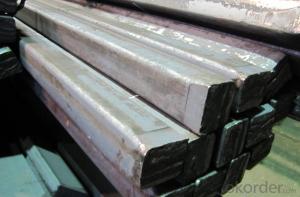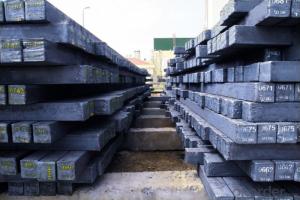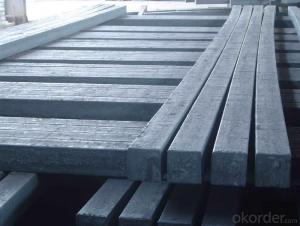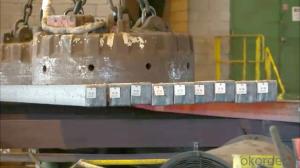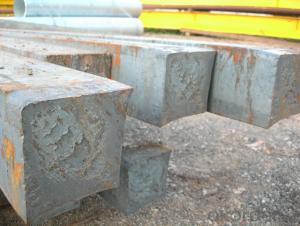Hot Rolled Steel Billet 3SP Standard 180mm
- Loading Port:
- Shanghai
- Payment Terms:
- TT OR LC
- Min Order Qty:
- 100 m.t.
- Supply Capability:
- 10000 m.t./month
OKorder Service Pledge
OKorder Financial Service
You Might Also Like
Structure of Hot Rolled Steel Billet 3SP Standard 180mm

Description of Hot Rolled Steel Billet 3SP Standard 180mm
Prepainted Rolled steel Coil is a kind of coated steel coil/sheet. With the cold rolled steel of different strength and thickness as substrate, it is produced through applying Al-Zn coat on both faces by hot dip process. In its coating, Al accounts for about 55%, Si 1.6%, while the remaining is Zn. Aluminum zinc coils enjoys both the physical protective feature and durability of Al and the electrochemical protective property of Zn. And its surface has bright silver color and regular embossed-like figure, which are highly decorative. RAL Scale Z35 Prepainted Rolled Steel Coil for Construction Roofing

Main Feature of Hot Rolled Steel Billet 3SP Standard 180mm
1.Corrosion resistance: It mainly depends on the zinc protection. When the zinc being worn,
2. Heat resistance: steel sheet has excellent heat resistance, can withstand high temperatures over 300 centigrade, and is similar with aluminized steel high temperature oxidation resistance. It often used in chimney pipes, ovens, fluorescent lighting device and the device cover.
3. Heat reflective: Galvanized steel plate heat-reflective high rate is twice as galvanized steel, often used to make insulation materials. RAL Scale Z35 Prepainted Rolled Steel Coil for Construction Roofing
Applications of Hot Rolled Steel Billet 3SP Standard 180mm
1. Construction and building: roofing; ventilating duct; handrail; partition panel;etc.
2. Electric appliance: refrigerator; washing machine; refrigerator; DVD;etc.
3.Transportation: oil tank; gas tank;road sign; etc.
4.Agriculture constructions :barn; etc.RAL Scale Z35 Prepainted Rolled Steel Coil for Construction Roofing
5.Others:vending machine; game machine; auto parts spare parts etc.
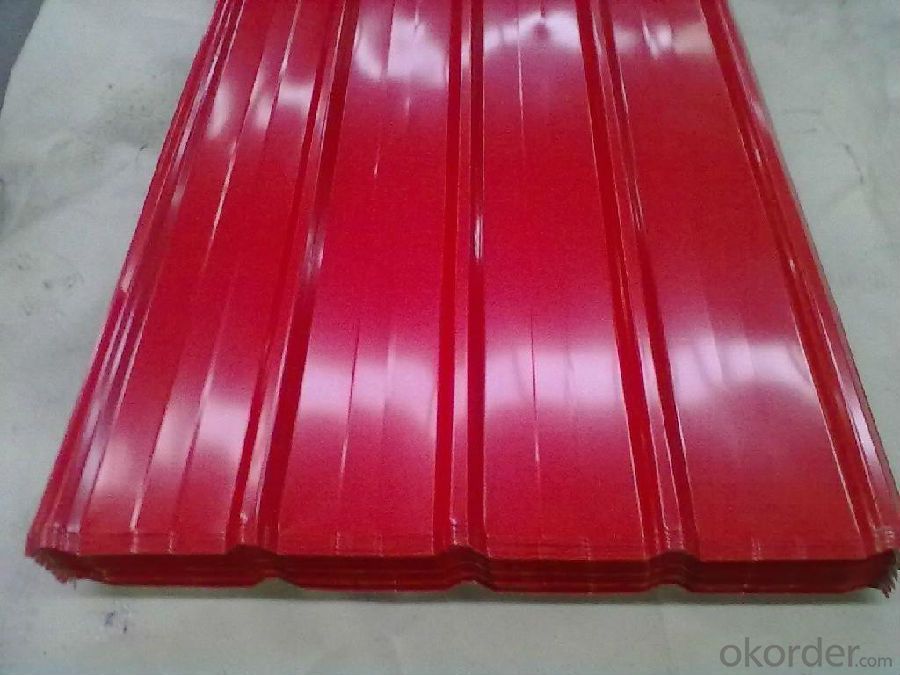
Specifications of Hot Rolled Steel Billet 3SP Standard 180mm
Product | Hot Rolled Steel Billet 3SP Standard 115mm |
Material Grade | SGCC / SGCH / DX51D+AZ, etc |
Thickness | 0.5-3.0mm |
Width | 700-1500mm |
Tolerance | Thickness: +/-0.02mm , Width:+/-2mm |
Zinc-coating | AZ30-150g/m2 |
Technique | Raw material: Hot rolled steel coil --> Cold rolled_>hot dipped galvalume |
Surface | Dried, Chromated, Unoiled,RAL Scale Z35 Prepainted Rolled Steel Coil for Construction Roofing |
Spangle | Regular spangle , small spangle, zero spangle |
ID | 508MM 610MM |
Coil weight | 25MT max |
Export package | Cardboard inner sleeves, Waterproof paper, galvanized steel covered and steel strip packed |
FAQ of Hot Rolled Steel Billet 3SP Standard 180mm
We have organized several common questions for our clients,may help you sincerely:
1. What is the minimum order quantity ?
Our MOQ is 100 mt for each size each specification. Usually we can offer discount if can buy large QTY once. RAL Scale Z35 Prepainted Rolled Steel Coil for Construction Roofing
2. How long can we receive the product after ordering?
Our general delivery time is 30 days after confirmation, but so some special orders, we have offer special delivery time
3. How to guarantee the quality of the products?
We have established the international advanced quality management system ,every link from raw material to final product we have strict quality test;We resolutely put an end to unqualified products flowing into the market. At the same time, we will provide necessary follow-up service assurance.
4. What is the payment?
We accept T/T, L/C
- Q:Can steel billets be polished for improved surface finish?
- Yes, steel billets can be polished to achieve an improved surface finish. Polishing is a mechanical process that involves removing a thin layer of the material's surface to smooth out any imperfections or roughness. It can be done using various techniques such as abrasive polishing, chemical polishing, or electrochemical polishing. Polishing steel billets not only enhances their aesthetic appeal but also improves their functional properties. A polished surface reduces friction, which can be beneficial in applications where smooth movement or reduced wear is required. Additionally, a polished surface can improve the corrosion resistance of steel by creating a barrier against environmental factors. However, it is important to note that the extent to which a steel billet can be polished depends on its composition and properties. Some alloys may be more easily polished than others, and certain surface finishes may require more extensive polishing processes. It is also crucial to consider the desired application and the specific requirements for the steel billets before deciding on the appropriate polishing method.
- Q:What is the lifespan of a steel billet?
- The lifespan of a steel billet is indefinite as long as it is properly stored and maintained, making it a durable and long-lasting material.
- Q:Can steel billets be used in the production of medical equipment?
- Yes, steel billets can be used in the production of medical equipment. Steel is commonly used in the manufacturing of medical devices and equipment due to its strength, durability, and resistance to corrosion. Steel billets are often processed and shaped into specific components or parts required for medical equipment, such as surgical instruments, implants, and diagnostic tools.
- Q:How are steel billets manufactured?
- Steel billets are manufactured through a process called continuous casting, which is the most common method used in the steel industry. This process involves pouring molten steel into a water-cooled mold, where it solidifies and takes the shape of a rectangular or square cross-section. The molten steel is typically obtained from a steelmaking furnace, such as a basic oxygen furnace or an electric arc furnace. Before the casting process begins, the mold is preheated to prevent the molten steel from solidifying prematurely. Once the mold is ready, the molten steel is poured into it through a ladle or a tundish, which helps control the flow of the liquid steel and removes impurities. As the molten steel enters the mold, it starts to cool rapidly due to the water-cooled walls of the mold. This rapid cooling leads to the solidification of the outer layer of the steel, forming a solid shell. The cooling process continues as the steel moves through the length of the mold, with water being sprayed on it to accelerate solidification. Once the solidified steel reaches the end of the mold, it is cut into desired lengths using a cutting torch or a mechanical shear. These solidified steel pieces, known as billets, are then transferred to a cooling bed or a roller table, where they continue to cool and solidify further. After sufficient cooling, the billets are inspected for any surface defects or other irregularities. Depending on the quality requirements, the billets may undergo further processing, such as heat treatment or surface conditioning, to improve their mechanical properties and surface finish. Overall, the continuous casting process allows for the efficient and cost-effective production of steel billets, which serve as a crucial raw material for various downstream steel products, such as bars, rods, and wire rods.
- Q:What are the main challenges in the marketing of steel billets?
- One of the main challenges in the marketing of steel billets is the highly competitive nature of the industry. There are numerous suppliers and manufacturers of steel billets globally, which creates a saturated market and makes it difficult for companies to differentiate their products and stand out from the competition. Additionally, fluctuations in steel prices and demand can impact the marketing efforts, as companies need to constantly adapt their strategies to changing market conditions. Another challenge is the need for extensive product knowledge and understanding of customer requirements, as steel billets are used in a wide range of industries with specific specifications and standards. Building strong relationships with customers and providing tailored solutions is crucial in overcoming these challenges and successfully marketing steel billets.
- Q:Are steel billets susceptible to corrosion?
- Yes, steel billets are susceptible to corrosion.
- Q:Can steel billets be used for decorative purposes?
- Indeed, steel billets have the potential to serve as decorative elements. Steel billets act as the primary material utilized in an array of applications within the steel industry, including the creation of ornamental goods. Through the implementation of diverse techniques like forging, casting, or machining, steel billets can undergo a metamorphosis into visually pleasing decorative pieces, such as sculptures, ornamental gates, furniture, architectural components, and more. Steel's adaptability and longevity make it a favored choice for decorative purposes, as it can be molded into intricate designs and endure outdoor conditions. Furthermore, steel can be further enhanced with a variety of finishes, like painting, powder coating, or patina, to heighten its visual allure and complement a wide range of styles or aesthetics.
- Q:How are steel billets different from steel ingots?
- Steel billets and steel ingots, although both semi-finished steel products, vary in their shape, size, and manufacturing process. To begin with, the shape of steel billets and steel ingots differs. Steel billets generally have a square or rectangular shape, with dimensions determined by production requirements. Conversely, steel ingots possess a more irregular shape, often resembling a large block or loaf. The mold used for casting determines the shape of the ingot. Furthermore, the size of steel billets and steel ingots also varies. Billets are typically smaller in size compared to ingots. They are produced with smaller cross-sectional areas and lengths, making them suitable for further processing. In contrast, steel ingots are larger and heavier, as they are cast in molds capable of accommodating a greater volume of molten steel. Finally, the manufacturing process for steel billets and steel ingots differs. Steel billets are typically produced through continuous casting, a process in which molten steel is poured into a water-cooled mold to solidify into the desired shape. This method allows for controlled and efficient production of billets. On the other hand, steel ingots are generally produced through casting in open or closed molds, where the molten steel is poured and left to solidify. This process tends to be slower and less precise compared to continuous casting. In conclusion, steel billets and steel ingots differ in terms of their shape, size, and manufacturing process. Billets are square or rectangular in shape, smaller in size, and produced through continuous casting, whereas ingots possess an irregular shape, larger in size, and are produced through casting in molds. Both products serve as crucial raw materials for the production of various steel products.
- Q:How are steel billets used in the production of forged parts?
- Steel billets are used in the production of forged parts as they serve as the starting material for the forging process. The billets are heated to a specific temperature and then shaped into the desired form by applying pressure or impact using a forging press or hammer. This process enhances the strength and durability of the steel, resulting in high-quality forged parts that are used in various industries such as automotive, aerospace, and construction.
- Q:Can steel billets be used in the production of electrical appliances?
- Yes, steel billets can be used in the production of electrical appliances. They can be used as raw material to manufacture various components such as motors, casings, and structural parts in electrical appliances.
1. Manufacturer Overview |
|
|---|---|
| Location | |
| Year Established | |
| Annual Output Value | |
| Main Markets | |
| Company Certifications | |
2. Manufacturer Certificates |
|
|---|---|
| a) Certification Name | |
| Range | |
| Reference | |
| Validity Period | |
3. Manufacturer Capability |
|
|---|---|
| a)Trade Capacity | |
| Nearest Port | |
| Export Percentage | |
| No.of Employees in Trade Department | |
| Language Spoken: | |
| b)Factory Information | |
| Factory Size: | |
| No. of Production Lines | |
| Contract Manufacturing | |
| Product Price Range | |
Send your message to us
Hot Rolled Steel Billet 3SP Standard 180mm
- Loading Port:
- Shanghai
- Payment Terms:
- TT OR LC
- Min Order Qty:
- 100 m.t.
- Supply Capability:
- 10000 m.t./month
OKorder Service Pledge
OKorder Financial Service
Similar products
New products
Hot products
Related keywords
